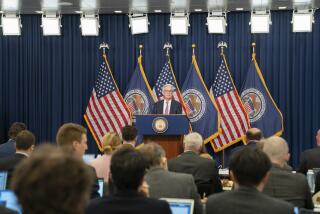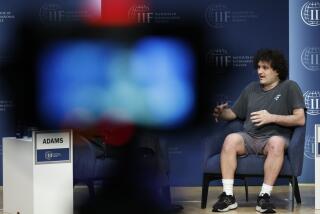Ex-Fed chief was slow to see credit risk
- Share via
WASHINGTON — Even the maestro didn’t see it coming.
Former Federal Reserve Chairman Alan Greenspan has acknowledged that he failed to recognize early on that an explosion of sub-prime mortgages to people with questionable credit histories or low incomes could pose a danger to the economy.
In an interview, Greenspan said he was aware of lending practices in which home buyers got very low initial rates only to see them jacked up later, causing payment shock in some cases. But he said he didn’t initially realize the harm they could do.
“While I was aware a lot of these practices were going on, I had no notion of how significant they had become until very late,” he said in a “60 Minutes” interview to be broadcast Sunday on CBS. “I really didn’t get it until very late in 2005 and 2006.”
An excerpt of the interview was released Thursday.
As Fed chief, Greenspan’s handling of the economy earned him laudatory monikers including maestro, the greatest central banker who ever lived and the second-most-important person in Washington.
Yet some wonder whether the Greenspan Fed could have done more to prevent lax lending standards, bad loans and other problems that have since come to light in the higher-risk sub-prime mortgage market.
A meltdown in that market has rocked Wall Street. Foreclosures and late payments have soared and many lenders have gone out of business. Nervous financial institutions have tightened credit standards, making it harder for even creditworthy borrowers to get financing. This has increased the risk that the economy will slide into a recession.
Sen. Charles E. Schumer (D-N.Y.) said: “Greenspan was one of the smartest regulators this country ever had. If he missed it, then it should be a warning to the current regulators about the depth of this crisis.”
Greenspan, who ran the central bank for more than 18 years, left in 2006. His successor, Ben S. Bernanke, has had to deal with a credit and financial crisis stemming from the sub-prime mortgage mess.
When he was at the helm, Greenspan maintained that there was little the Fed -- which also oversees the safety and soundness of banks -- could do about the sub-prime situation. One of the Fed’s governors, however, had raised a red flag about questionable lending practices.
“Well, it was nothing to look into particularly because we knew there was a number of such practices going on, but it’s very difficult for banking regulators to deal with that,” Greenspan said in the interview.
Some analysts have blamed Greenspan’s interest-rate policies for feeding the housing frenzy. Sales hit record highs and house prices soared from 2001 to 2005. Then the market fell into a deep slump.
The Greenspan Fed slashed interest rates from early 2001 to the summer of 2003 to their lowest level in decades. It was done to rescue the economy from the bursting of the stock market bubble, the 2001 recession, the Sept. 11 terrorist attacks and a wave of accounting scandals that shook Wall Street.
Critics say the Fed kept rates too low for too long, encouraging a Wild West mentality in housing.
Greenspan, however, defended the institution’s actions.
“They are mistaken,” he said of the critics. “It was our job to unfreeze the American banking system if we wanted the economy to function. This required that we keep rates modestly low.”
Some believe that Greenspan would have acted more aggressively than Bernanke in dealing with the current financial crisis. “I’m not sure that’s true,” Greenspan said. “I think [Bernanke] is doing an excellent job.”
Greenspan has written a book, “The Age of Turbulence,” that looks back on his life and his days as Fed chief. It will be released Monday.
More to Read
Inside the business of entertainment
The Wide Shot brings you news, analysis and insights on everything from streaming wars to production — and what it all means for the future.
You may occasionally receive promotional content from the Los Angeles Times.










